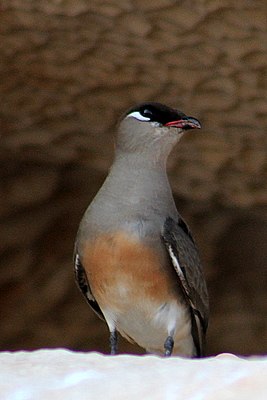Madagascar Swallow
| Madagascar Swallow | ||||||||||||
|---|---|---|---|---|---|---|---|---|---|---|---|---|

Madagascar Swallow |
||||||||||||
| Systematics | ||||||||||||
|
||||||||||||
| Scientific name | ||||||||||||
| Glareola ocularis | ||||||||||||
| Verreaux , 1833 |
The Madagascar curlew ( Glareola ocularis ) is a bird from the subfamily of the curlew-like (Glareolidae).
It occurs in the Comoros , Ethiopia , Kenya , Madagascar , Mozambique , Somalia and Tanzania , possibly also on Mauritius and Réunion .
The distribution area includes short grass areas, like salt pans and sandy coastlines, also airfields, open habitats close to the water up to 1500 m.
description
The Madagascar curlew is 23-25 cm tall and weighs 82-103 g. The upper side is dark olive brown, the forehead dark chocolate brown, the reins and the ear covers are blackish, the base of the beak is reddish. The under-eye stripe and the trunk are white, the lower chest area is chestnut-colored. The tail is slightly split.
voice
The male's call is described as a loud, descending “vik vik, vikavik, vikavik”.
Way of life
The diet consists mainly of insects including hymenoptera , reticulated winged beetles and beetles .
The bird only breeds in Madagascar, with the exception of the extreme south and southwest, between September and March on rocky islands in non-drying rivers and coastal waters. He winters in East Africa from Somalia to Mozambique .
Danger
The Madagascar whorl is considered to be endangered ( Vulnerable ).
Web links
- Videos, photos and sound recordings of Glareola ocularis in the Internet Bird Collection
Individual evidence
- ↑ Avibase
- ↑ a b Handbook of the Birds of the World
- ^ A b c d F. Hawkins, R. Safford, A. Skerrett: Birds of Madagascar and the Indian Ocean Islands. Helm Field Guides, 2015, ISBN 978-1-4729-2409-4
- ^ T. Stevenson, J. Fanshawe: Birds of East Africa. Kenya, Tanzania, Uganda, Rwanda, and Burundi , Princeton University Press, 2002, ISBN 0-691-12665-8
- ^ IUCN Redlist